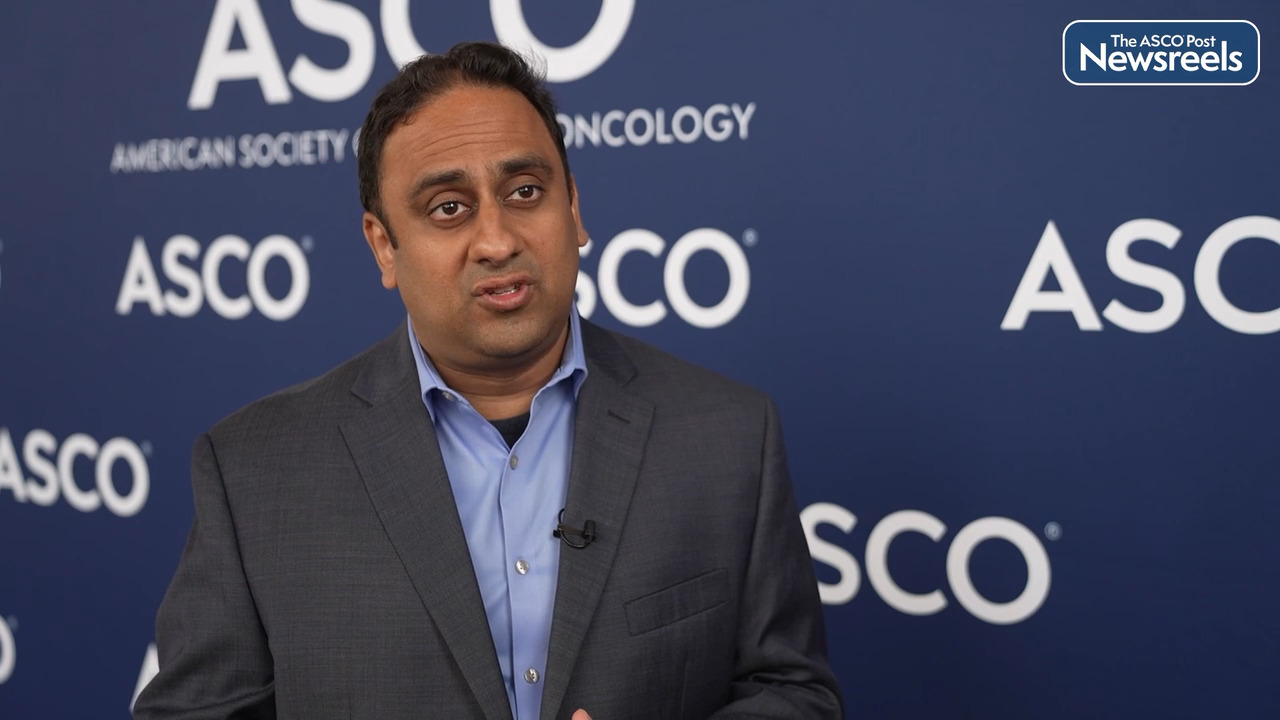Sebastian Stintzing, MD, on Colorectal Cancer: Influence of Liquid Biopsy in First-Line Combination Treatment
2023 ASCO Annual Meeting
Sebastian Stintzing, MD, of the Charité Universitätsmedizin Berlin, discusses results from the phase III FIRE-4 study, which showed that liquid biopsy is clinically relevant in verifying mutational status in patients with metastatic colorectal cancer and is efficacious in first-line treatment of FOLFIRI and cetuximab for patients with RAS wild-type disease (Abstract 3507).
Transcript
Disclaimer: This video transcript has not been proofread or edited and may contain errors.
The purpose of the FIRE-4 study was to test whether a switch maintenance from an anti-EGFR containing regimen first-line to bevacizumab plus [inaudible 00:00:19] would prevent upcoming RAS mutations as secondary resistant factors and therefore prolong progression-free survival over the median time that is reached with the standard treatment of FOLFIRI plus cetuximab. Therefore, we randomized 672 patients in either FOLFIRI plus cetuximab until progression or intolerable toxicity versus FOLFIRI cetuximab up to eight and 12 cycles, and then switch maintenance towards [inaudible 00:00:52] and bevacizumab.
Primary endpoint of the first line treatment was PFS and we have published this in last year, we did not reach a PFS. PFS of both arms was comparable. At this ASCO, we present the data of the liquid biopsy translational program. We took liquid biopsies at the beginning, at baseline, at the 6 to 12 cycles within treatment. And then at the end of the treatment, at progression. What was quite unexpected, this was a RAS wide type population by tissue-based testing within the liquid biopsy, we were able to find 13% of patients having a RAS mutation at baseline. And the outcome of those patients were as expected for RAS mutant patients. At PFS of roundabout nine months and overall survival of 22 months, whereas the double Y type population, the RAS and BUFY type population exceeded the PFS with 11.5 months and then overall exceeding in median 33 months.
We also had the on treatment measurement of liquid biopsy and was quite interesting. It took in median 48 weeks until the RAS mutation came up in those patient treated continuously with anti-EGFR treatment. Almost after one year of treatment, there were upcoming RAs mutations and we found those in round about 19%. One out of five patients got to this RAS mutation. It did not impact overall survival.
What are our conclusions here? First of all, baseline liquid biopsy is important to find the right patient population and to sort out those patient who may have a RAS wide type tumor by tissue-based analysis, but a RAS mutant tumor by liquid biopsy because those patients do not derive benefit from anti-EGFR treatment. At baseline it's important, it's meaningful. During treatment, we think there's no meaning for the RAS testing by liquid biopsy because those patients who actually got a RAS mutation during treatment have a very long treatment time, are on treatment for almost a year. And it has no impact on overall survival.
What would be the next steps? In my opinion, we should do a liquid biopsy in our clinical practice before starting anti-EGFR treatments or at baseline to cover tumor heterogeneity and to cover the real RAS mutational status of our patients that we want to treat. B, I think it'll be important to find a threshold during treatment where we can apply treatment holidays. Where's the threshold? How far can we actually treat the patients? How far can we shrink down the tumor volume until it is safe to say, okay, now we can do a treatment holiday, just to give the patient a break and from a patient perspective to have a better quality of life during this treatment course.
The ASCO Post Staff
Nirav N. Shah, MD, of the Medical College of Wisconsin, discusses phase II results showing that split-dose R-CHOP offers older patients with diffuse large B-cell lymphoma (DLBCL) an equivalent dose intensity as R-CHOP-21 through a fractionated dosing schedule, improving tolerability. At the end of treatment for these older patients, a complete response rate of 71% was comparable to outcomes with R-CHOP in younger patients with the disease (Abstract 7554).
The ASCO Post Staff
Jonathan W. Riess, MD, of the University of California, Davis Comprehensive Cancer Center, explores the findings of three important clinical trials in lung cancer treatment: whether to incorporate immune checkpoint inhibitors into the treatment of EGFR-mutated lung cancer, the importance of central nervous system activity in EGFR-mutant lung cancer, and new therapies for disease with EGFR exon 20 insertion.
The ASCO Post Staff
Clifford A. Hudis, MD, ASCO Chief Executive Officer, talks about extending the reach and impact of ASCO by partnering with patients who play a key role in advancing science through clinical trial participation. With near-record numbers of registered attendees, the 2023 Annual Meeting fostered new connections and plans for collaborations.
The ASCO Post Staff
Tycel J. Phillips, MD, and Alex F. Herrera, MD, both of the City of Hope National Medical Center, discuss findings from the POLARIX study, which provided the largest prospectively collected circulating tumor DNA (ctDNA) data set on patients with previously untreated diffuse large B-cell lymphoma. Achieving ctDNA-negative status was associated with improved outcomes when patients were treated with polatuzumab vedotin-piiq plus combination chemotherapy vs combination chemotherapy alone (Abstract 7523).
The ASCO Post Staff
Shilpa Gupta, MD, of Cleveland Clinic, discusses the results from the EV-103 study and the unmet need for effective first-line therapies in cisplatin-ineligible patients with locally advanced or metastatic urothelial carcinoma. After nearly 4 years of follow-up, the trial findings showed that enfortumab vedotin-ejfv plus pembrolizumab continues to demonstrate promising survival trends with rapid and durable responses in this population (Abstract 4505).





